New dialog box (Show all comic settings) [PRO/EX]
These are the settings that appear when [Show all comic settings] is selected as the [Use of work].
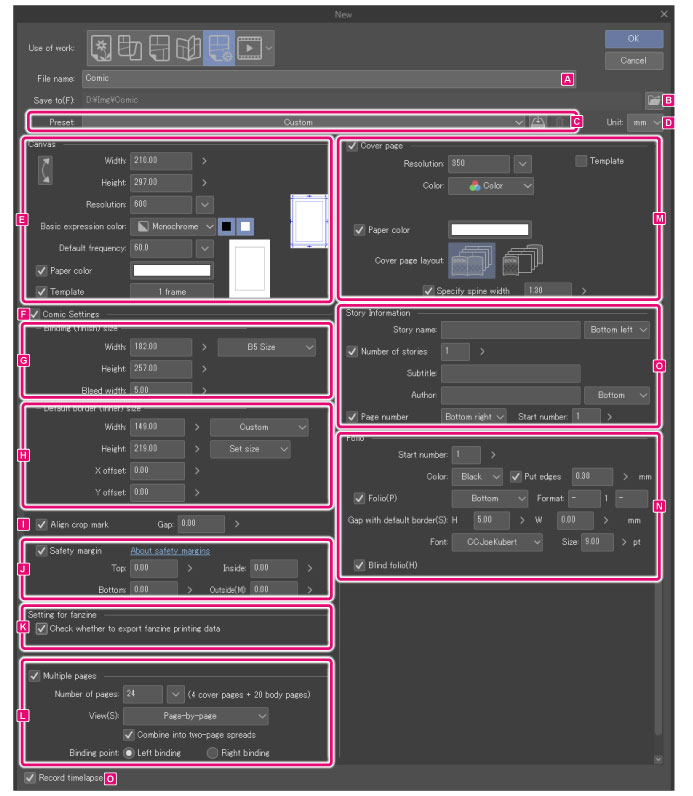
|
|
In EX, you can change settings for multiple pages, cover pages, story information, and the folio after creating the file. To learn about these settings, see "Change basic work settings". |
A.File name
Enter a save name for your file.
When creating a work with multiple pages in EX, this will be the name of the page management file (extension: cmc). The entered file name will also be used as the name of the management folder.
B.Save to [EX]
Specifies the location where the management folder will be created. Click [Browse] to specify the location. This option appears when [Multiple pages] is turned on.
|
|
In EX, works made of multiple pages are stored inside a management folder as the management file and separate Clip Studio format files for each page. For details, see “Regarding Management File and Page Files”. |
C.Preset

(1) Preset
Select the finish size and resolution from a list of options. Registered presets can also be selected when other items are selected in [Use of work].
|
|
If you change the settings of a preset, the selected option will automatically change to [Custom]. |
(2) Register to preset
Registers the current settings in the dialog box as [Preset]. Clicking the button opens the [Register to preset] dialog box. In the dialog box, set the preset name and settings to be included in the preset, then click [OK].
|
|
For details on the [Register to preset] dialog box, see "Register to preset Dialog Box". |
(3) Delete preset
You can delete presets selected from the [Preset] list.
|
|
The preset list for [Show all comic settings] includes presets for other types of projects. This means that if a preset registered for another [Use of work] is deleted, the preset will be deleted from this list as well. |
|
|
You can only delete presets that you have registered yourself. Default presets cannot be deleted. |
D.Unit
Select a unit for the width and height. You can choose from centimeters, millimeters, inches, pixels, or points.
E.Canvas
Adjust settings related to the canvas.
|
|
·When [Manga draft settings] is turned off, the canvas size will be the final size. ·When [Manga draft settings] is turned on, the [Binding (finish) size] will be the final size when bound in a book. |

(1) Swap width/height
Swaps the width and height of the canvas (page).
(2) Width
Horizontal length to print.
(3) Height
Vertical length to print.
(4) Resolution
Sets the resolution of the canvas (pages). Click the drop-down button next to it to select a value.
(5) Basic expression color
Sets the basic expression color. You can choose from [Color], [Gray], or [Monochrome].
|
|
The expression color [Monotone] from Ver.1.2.1 and earlier will be converted into the following [basic expression color] and [drawing color]. ·Basic expression color: Gray ·Drawing color: Only black |
(6) Drawing colors
Set the drawing colors when using [Gray] or [Monochrome] basic expression colors. You can set the drawing colors using the black and white square icons.
Gray
You can set drawing colors in the following ways with the black and white buttons.
|
Only black |
The drawing colors will be grayscale from black to transparency. |
|
Only white |
The drawing colors will be grayscale from white to transparency. |
|
Both black and white |
The drawing colors will be grayscale from black to white. |
Monochrome
You can set drawing colors in the following ways with the black and white buttons.
|
Only black |
The drawing colors will be black and transparency only. |
|
Only white |
The drawing colors will be white and transparency only. |
|
Both black and white |
The drawing colors will be black, white, and transparency only. |
|
|
For details on expression colors and drawing colors, see "Explanation: Expression Color and Drawing Color". |
(7) Default frequency
Specify the number of screentone lines per inch. Larger values result in smaller dots. This appears when the basic expression color is set to [Gray] or [Monochrome].
(8) Paper color
Turn this on to choose the color of the paper layer. Click the color indicator to open the [Color settings] dialog box. Specify a color to change the color of the Paper layer.
|
|
·The Paper layer is a single-color layer at the bottom of the layer palette. When the paper layer is hidden, transparent areas of the canvas will be shown in a checkered pattern. ·The Paper layer color can be changed afterwards. You can double-click the Paper layer in the [Layer] palette to display the [Color settings] dialog box and change the color of the Paper layer. ·For details on the [Color settings] dialog box, see "Advanced settings of color Dialog Box". |
(9) Template
Allows you to create a page file with an imported template.
Select the checkbox and click the button to open the [Template] dialog box. Specify the template to import to the page file in the dialog box.
|
|
If a template has previously been specified, the template title will appear as a button beside the checkbox. Click this button to open the [Template] dialog box. |
(10) Specified template
Clicking this button opens the [Template] dialog box. Specify the template to import to the page file in the dialog box.
|
|
For details on the settings in the [Template] dialog box, see "Template Dialog Box [PRO/EX]". |
F.Manga draft settings
Turn this on to add crop marks, default border (inner), cropped border, bleed border and safety margin to the canvas. After setting up sizes for the bleed border, default border and safety margin, these guidelines can be displayed on the canvas.
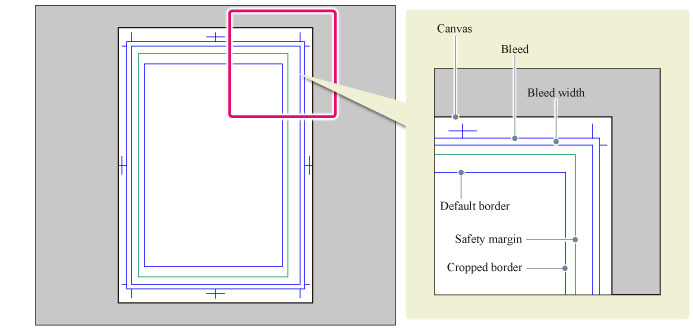
G.Manga draft settings > Binding (finish) size
This sets the border at which the edge of the pages will be trimmed for binding after printing. Drawings within these dimensions will be printed. You can also add an extra safety margin to deal with misaligned trimming of the printed pages. These options appear when [Manga draft settings] is turned on.
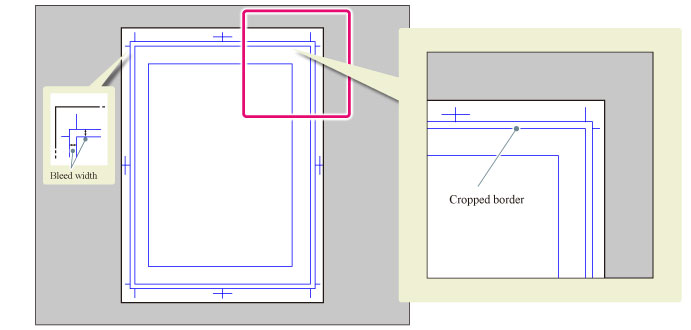
(1) Width
Horizontal length to print.
(2) Height
Vertical length to print.
(3) Bleed width
Add an extra margin to compensate for misaligned trimming of the edges of the pages. To print to the edge of the page, draw up to the bleed width area.
The area between the bleed border (the first border from the edge) and the finish border (the second border from the edge) is the bleed area.
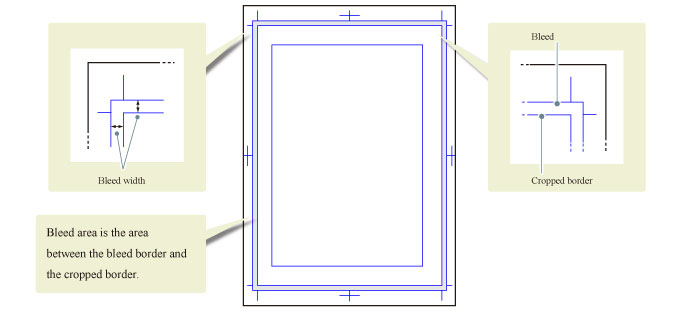
(4) Default size (Cropped border)
Allows you to select a width and height for the finish size from default sizes.
H.Manga draft settings > Default border (inner) size
This is a reference border for laying out frames. There are two ways of specifying the default border: by size and position, or by margin. This option appears when [Manga draft settings] is turned on.
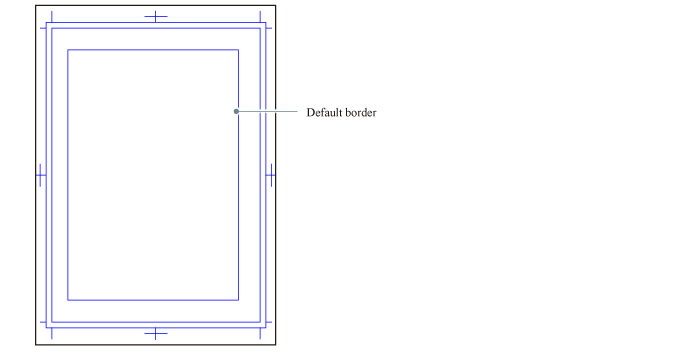
(1) Default size (Default border)
Allows you to select a width and height for the default border from default sizes.
(2) How to specify default border
You can choose how to specify the size and position of the default border. The options vary depending on the default border settings.
|
Set size |
Adjust the size and position of the default border. |
|
Set margin |
Adjust the default border based on the distance from the edges of the paper. |
(3) Default border settings
Sets the size and position of the default border. The options vary depending on the method of specifying the border.
Set size
Adjust the size and position of the default border.
|
Width |
Width of the default border. |
|
Height |
Length of the default border. |
|
X offset |
Horizontal position of the default border. |
|
Y offset |
Vertical position of the default border. |
|
|
·When [X offset] is 0, the default border will be located in the center of the finish border horizontally. ·When [Y offset] is 0, the default border will be located in the center of the finish border vertically. |
Set margin
Adjust the default border based on the distance from the edges of the cropped border.
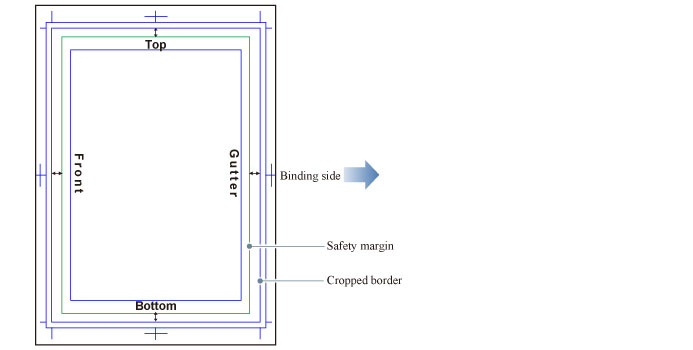
|
Top |
Specifies the upper side of the default border as the distance from the top of the cropped border. |
|
Bottom |
Specifies the lower side of the default border as the distance from the bottom of the cropped border. |
|
Inside |
Specifies the right or left side of the default border as the distance from the direction of the binding point. |
|
Outside |
Specifies the right or left side of the default border as the distance from the outer edge of the page (opposite side to the binding point). |
I.Manga draft settings > Safety margin
Turn this on to add a safety margin to the canvas. When printing magazines and books with different aspect ratios, the position of the bleed border changes depending on the format. The safety margin indicates the print-safe area for both magazines and books. Usually, publishers and printing companies specify its position.
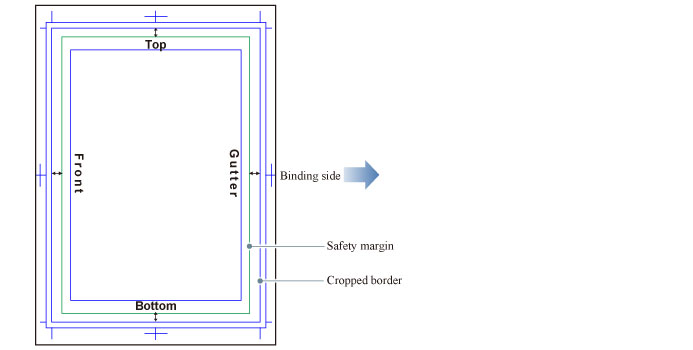
|
Top |
Specifies the upper side of the safety margin as the distance from the top of the cropped border. |
|
Bottom |
Specifies the lower side of the safety margin as the distance from the top of the cropped border. |
|
Inner |
Specifies the left/right side of the safety margin as the distance from the cropped border on the binding side. |
|
Outside |
Specifies the left/right side of the safety margin as the distance from the cropped border on the outer side of the page. |
J.Align crop mark [EX]
Sets whether or not to align crop marks on two-page spreads.
When turned off, crop marks are created at the position where the paper edges of the left and right pages match.
When turned on, the crop marks are combined by aligning the positions of the cropped border. The position of the cropped border on the left and right pages can be adjusted in [Gap].
|
|
The [Align crop mark] setting is available when [Combine into two-page spreads] is turned on under [Multiple pages]. |
K.Setting for fanzine [EX]
(1) Check whether to export fanzine printing data
Turn this on to check whether the file can be exported as fanzine printing data. If the data cannot be exported as fanzine printing data, a message will appear when you click the [OK] button in the [New] dialog box.
L.Multiple pages [EX]
You can create a work consisting of multiple pages and configure settings such as the number of pages and binding direction.

(1) Multiple pages
Turn this on to create a file with multiple pages.
(2) Number of pages
Sets the number of pages to create. Click the drop-down button next to it to select the amount.
|
|
·If [Cover page] is turned on, include the cover page when setting the number of pages. ·The numbers of pages that can be selected depend on the settings. |
(3) View *
You can choose from the following views. The settings and [Story] window will change depending on the view.
|
Page-by-page |
Pages will be optimized for works with page turns such as bound books. |
|
Webtoon |
Pages will be optimized for vertical scrolling works such as webtoons. |
(4) Combine into two-page spreads
Turn this on to connect sets of left and right pages as two-page spreads.
|
|
You can set it up by selecting [Page-by-page] under [View]. |
(5) Binding point
Selects the direction in which to bind the book. Select either [Left binding] or [Right binding].
|
|
·Generally, [Left binding] is used for Western-style comics, and [Right binding] is used for Japanese-style manga. ·You can set it up by selecting [Page-by-page] under [View]. |
(6) Start page
Sets which side to put the first page.
·When starting with a left page, select [From left].
·When starting with a right page, select [From right].
|
|
·The [Start page] setting is not available when [Cover page] is turned on. ·You can set it up by selecting [Page-by-page] under [View]. |
M.Cover page [EX]
Add a cover page and adjust settings, including drawing colors and resolution.

(1) Cover page
Turn this on to add a cover page to your work and show the canvas and layout settings.
(2) Resolution
Sets the resolution of the cover page. Click the drop-down button next to it to select a value.
(3) Basic expression color
Sets the basic expression color. You can choose from [Color], [Gray], or [Monochrome].
|
|
The expression color [Monotone] from Ver.1.2.1 and earlier will be converted into the following [basic expression color] and [drawing color]. ·Basic expression color: Gray ·Drawing color: Only black |
(4) Drawing colors
Sets the drawing color if the basic expression color is set to either [Gray] or [Monochrome]. You can set the drawing color by selecting one of the black and white square icons.
Gray
You can set drawing colors in the following ways with the black and white buttons.
|
Only black |
The drawing colors will be grayscale from black to transparency. |
|
Only white |
The drawing colors will be grayscale from white to transparency. |
|
Both black and white |
The drawing colors will be grayscale from black to white. |
Monochrome
You can set drawing colors in the following ways with the black and white buttons.
|
Only black |
The drawing colors will be black and transparency only. |
|
Only white |
The drawing colors will be white and transparency only. |
|
Both black and white |
The drawing colors will be black, white, and transparency only. |
|
|
For details on expression colors and drawing colors, see "Explanation: Expression Color and Drawing Color". |
(5) Default frequency
Specifys the number of screentone lines per inch. Larger values result in smaller dots. This appears when the basic expression color is set to [Gray] or [Monochrome].
(6) Paper color
This appears when the basic expression color is set to [Color]. It allows you to choose the color of the paper layer. Click the color indicator to open the [Color settings] dialog box. Specify a color to change the color of the Paper layer.
|
|
·The Paper layer is a single-color layer at the bottom of the layer palette. When the paper layer is hidden, transparent areas of the canvas will be shown in a checkered pattern. ·The Paper layer color can be changed afterwards. You can double-click the Paper layer in the [Layer] palette to display the [Color settings] dialog box and change the color of the Paper layer. ·For details on the [Color settings] dialog box, see "Advanced settings of color Dialog Box". |
(7) Cover page layout
Sets the placement of the front and back cover pages. You can select whether to create the front and back cover pages as a spread or to print them as separate pages.
(8) Specify spine width
Sets the spine width if the cover pages are to be printed as a spread. Turn this option to specify the width.
|
|
If the checkbox is not checked, the spine width will automatically be calculated. However, this value may differ from the actual spine width depending on the paper used for the body pages. |
(9) Template
Applies a template to the cover page. Select the checkbox to open the [Template] dialog box. Specify the template to import to the cover page in the dialog box.
|
|
If a template has previously been specified, the template title will appear as a button beside the checkbox. Click this button to open the [Template] dialog box. |
(10) Specified template
Clicking the template title button opens the [Template] dialog box. If you want to modify your template choice, click on a different template to import it to the cover page in the dialog box.
|
|
For details on the settings in the [Template] dialog box, see "Template Dialog Box [PRO/EX]". |
N.Story information [EX]
Enter information such as the story name, number of stories, subtitle, author, and page numbers. This information is displayed outside the bleed border, in the non-printable area. These are optional settings, so you can skip items that aren't relevant.

(1) Story name
Enter a title for the work. The pull down menu shows options for where to place the story name.
(2) Number of stories
When turned on, you can enter the number of stories in the work.
(3) Subtitle
Enter a subtitle for the comic or manga.
(4) Author
Enter the name of the author or author group. The pull down menu shows options for where to place the author name.
(5) Page number
Turn this on to add page numbers.The pull down menu shows options for where to place the page numbers.You can change the starting number with the [Start number] setting.
O.Folio [EX]
Adjusts settings for the page numbers that are shown when the pages are bound.

(1) Start number
Enter the starting page number.
(2) Color
Choose a color for the page numbers.You can select from black or white.
(3) Put edges
Turn this on to add a border around the page numbers.In the input field on the right, set the thickness of the border.
(4) Folio
Turn this on to show the page numbers on the printed page. The pull down menu shows options for where to place the page numbers.
(5) Format
Set the text to be added before and/or after the page number, if any. Input the text in the fields on the left and right, respectively.
(6) Gap with default border
Set the gap between the folio and the default border.A larger value increases the size of the gap.
(7) Font
Select the font to use for the page numbers.
(8) Size
Set the font size for the page numbers.
(9) Blind folio
When turned on, hidden page numbers are indicated in the lower part of the gutter (the side where the book is bound). Settings such as font and size cannot be configured for [Blind folio].
P.Record timelapse *
When enabled, starts recording a timelapse whenever a new canvas is created. If you save the file in Clip Studio format (extension: .clip), the timelapse will be saved with the file. For more detail on timelapses, see Clip Studio TIPS.









